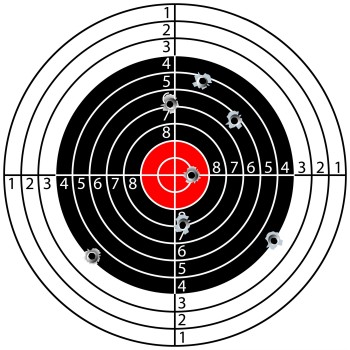Target Shooting
Aim to have a good time. Shoot for safety.
(USDA Forest Service illustration by Scott C. Marvin)Target shooting is generally allowed on National Forest System lands within the Dakota Prairie Grasslands if it adheres to specific regulations and restrictions.
Shooting refers to firearms, bow & arrow, or any device that can cause harm or destruction.
Here are a few requirements when recreating on national grasslands:
- Always report any instances of fire not in control by calling 911 immediately.
- Monitor for restrictions on the Alerts and Fire Danger bar above, and for any posted signage (Figure 1). Everyone is responsible for being informed.
- Always stay on existing roads and trails.
- All off-road, cross-country travel is prohibited except for dispersed camping, where vehicles may drive up to 300 feet off-road to camp along certain roads.
- Area Motor Vehicle Use Maps outline all off-road travel and are available on the Visitor Maps and Guides page.
- Restrict motorized travel to the major, improved-surface gravel roads during wet conditions. Vehicles cause ruts in soft ground and damage the ecosystem.
- Pack in, Pack Out. Take all spent firearms shells or casings, arrows, target remnants, and anything else brought to the grasslands. Keep America beautiful.
Localized information is available on the brochure for Target Shooting on the Little Missouri National Grassland.
Contact the local Ranger District Office for more information.
Shooting Prohibitions in the Grasslands
Figure 1. An illustration of a red circle with a red diagonal line and a silhouette of a firearm indicating that carrying firearms, such as pistols, is prohibited.
(Licensed illustration by kreasitekmedia/Adobe Stock photo. )Shooting prohibitions in grasslands aim to ensure safety, prevent resource damage, and protect the environment. These prohibitions generally include restrictions on discharging firearms near developed areas, across roads or bodies of water, and in specific sensitive areas like caves or archaeological sites.
Never shoot:
- Firing tracer bullets, incendiary ammunition, or binary explosive targets. These are restricted for use on the grasslands due to fire safety concerns.
- Clay targets, aka skeet clay pigeons or any other non-biodegradable materials.
- Disturbing, injuring, destroying, or in any way damaging any prehistoric, historic, or archaeological resource, structure, site, artifact, or property.
- In or within 150 yards of any campground, developed recreation area, residence, building, or occupied area.
- Across or on a national grassland road or any body of water.
- In any manner or place where any person or property is exposed to injury or damage due to such discharge.
- Into or within a cave.
Contact the local Ranger District Office for more information.
Firearms Target Practice Safety Tips
Figure 2. An illustration of a shooting target with bullet holes.
(Licensed illustration by michello81/Adobe Stock photo. )- Treat every gun as if it is loaded.
- Firearms should be unloaded when not in use.
- When unloading the firearm from the bag, make sure it's pointed down range.
- Always keep the muzzle pointed in a safe direction.
- Do not rely on the safety.
- Never let the muzzle of a firearm point at anything you do not intend to shoot.
- Keep your finger off the trigger until your sights are on the target and you are ready to shoot.
- Make sure of your target and what is beyond.
- Shoot only at authorized targets. Do not shoot at glass, metals, plastics, or electronic components.
- Do not have alcoholic beverages while discharging a firearm.
Contact the local Ranger District Office for more information.
Archery Target Practice Safety Tips
Figure 3. An illustration of an archery target with arrows in the center.
(Licensed illustration by backup16/Adobe Stock photo. )- Never point the bow and arrow at anything or anyone.
- Only nock an arrow (place it on the bowstring) when ready to shoot.
- Before shooting, check for people or obstacles in your shooting path and beyond.
- Always be sure of your target and what is behind it (Figure 3).
- Ensure a safe distance behind the target and a backstop to stop the arrow, such as a natural berm or a secure, bullet-proof backstop.
- Never fire at trees, bushes, and other plants.
- Wear an arm guard, finger protection (tab or glove), and sturdy shoes.
- Everyone in the area should wear eye protection.
- Never shoot an arrow into the air. You cannot predict where it will land.
- Wait for the appropriate signal before retrieving arrows.
- When carrying arrows, keep them in a quiver or with the nocks pointed down.
- Do not have alcoholic beverages while handling archery equipment.
Contact the local Ranger District Office for more information.







